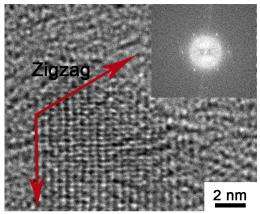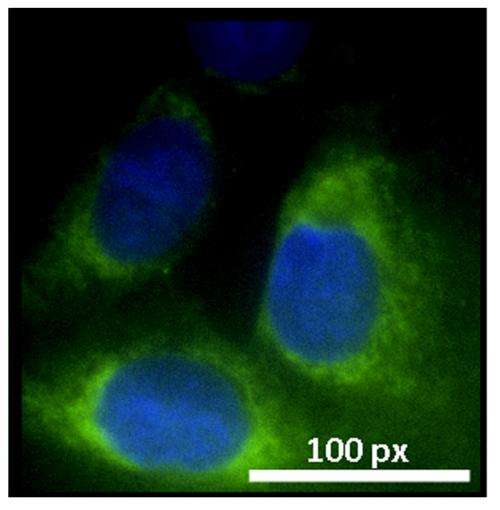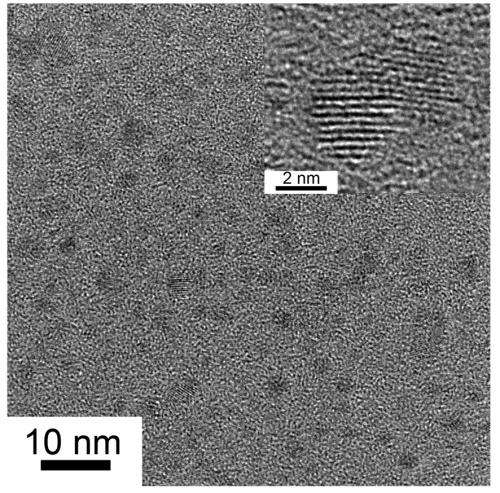Graphene quantum dots: The next big small thing

A Rice University laboratory has found a way to turn common carbon fiber into graphene quantum dots, tiny specks of matter with properties expected to prove useful in electronic, optical and biomedical applications.
The Rice lab of materials scientist Pulickel Ajayan, in collaboration with colleagues in China, India, Japan and the Texas Medical Center, discovered a one-step chemical process that is markedly simpler than established techniques for making graphene quantum dots. The results were published online this month in the American Chemical Society's journal Nano Letters.
"There have been several attempts to make graphene-based quantum dots with specific electronic and luminescent properties using chemical breakdown or e-beam lithography of graphene layers," said Ajayan, Rice's Benjamin M. and Mary Greenwood Anderson Professor of Mechanical Engineering and Materials Science and of Chemistry. "We thought that as these nanodomains of graphitized carbons already exist in carbon fibers, which are cheap and plenty, why not use them as the precursor?"
Quantum dots, discovered in the 1980s, are semiconductors that contain a size- and shape-dependent band gap. These have been promising structures for applications that range from computers, LEDs, solar cells and lasers to medical imaging devices. The sub-5 nanometer carbon-based quantum dots produced in bulk through the wet chemical process discovered at Rice are highly soluble, and their size can be controlled via the temperature at which they're created.

The Rice researchers were attempting another experiment when they came across the technique. "We tried to selectively oxidize carbon fiber, and we found that was really hard," said Wei Gao, a Rice graduate student who worked on the project with lead author Juan Peng, a visiting student from Nanjing University who studied in Ajayan's lab last year. "We ended up with a solution and decided to look at a few drops with a transmission electron microscope."
The specks they saw were bits of graphene or, more precisely, oxidized nanodomains of graphene extracted via chemical treatment of carbon fiber. "That was a complete surprise," Gao said. "We call them quantum dots, but they're two-dimensional, so what we really have here are graphene quantum discs." Gao said other techniques are expensive and take weeks to make small batches of graphene quantum dots. "Our starting material is cheap, commercially available carbon fiber. In a one-step treatment, we get a large amount of quantum dots. I think that's the biggest advantage of our work," she said.

Further experimentation revealed interesting bits of information: The size of the dots, and thus their photoluminescent properties, could be controlled through processing at relatively low temperatures, from 80 to 120 degrees Celsius. "At 120, 100 and 80 degrees, we got blue, green and yellow luminescing dots," she said.
They also found the dots' edges tended to prefer the form known as zigzag. The edge of a sheet of graphene -- the single-atom-thick form of carbon -- determines its electrical characteristics, and zigzags are semiconducting.
Their luminescent properties give graphene quantum dots potential for imaging, protein analysis, cell tracking and other biomedical applications, Gao said. Tests at Houston's MD Anderson Cancer Center and Baylor College of Medicine on two human breast cancer lines showed the dots easily found their way into the cells' cytoplasm and did not interfere with their proliferation.
"The green quantum dots yielded a very good image," said co-author Rebeca Romero Aburto, a graduate student in the Ajayan Lab who also studies at MD Anderson. "The advantage of graphene dots over fluorophores is that their fluorescence is more stable and they don't photobleach. They don't lose their fluorescence as easily. They have a depth limit, so they may be good for in vitro and in vivo (small animal) studies, but perhaps not optimal for deep tissues in humans.
"But everything has to start in the lab, and these could be an interesting approach to further explore for bioimaging," Romero Alburto said. "In the future, these graphene quantum dots could have high impact because they can be conjugated with other entities for sensing applications, too."
More information: Nano Lett., Article ASAP DOI: 10.1021/nl2038979
Provided by Rice University




















